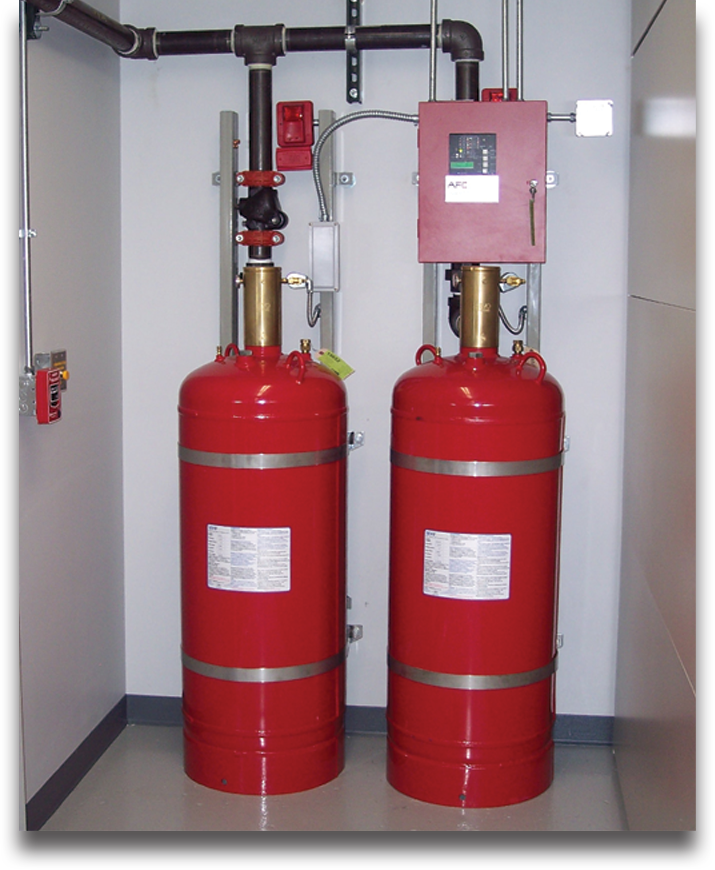Internal fire suppression systems used in modular vaults are designed to detect and extinguish fires within the vault to prevent the spread of flames and protect the contents. Some common types of internal fire suppression systems used in modular vaults include:
- Inert Gas (Clean Agent) Systems use non-toxic, electrically non-conductive gases, such as nitrogen, argon, or carbon dioxide, to displace oxygen and suppress the fire. By reducing the oxygen concentration in the vault, the fire is effectively starved of the oxygen required for combustion. These systems are particularly suitable for protecting valuable items and sensitive equipment, as the gases do not leave any residue and do not damage the contents.
- Water Mist Systems release a fine mist of water droplets to cool down the fire and displace oxygen, suppressing the flames. These systems are effective in controlling fires and reducing heat without causing significant water damage to the vault’s contents.
- Foam Suppression Systems use a mixture of water and foam concentrate to create a foam blanket that smothers the fire, cutting off its oxygen supply. Foam systems are suitable for vaults storing flammable liquids or materials.
- Pre-Action Systems combine a detection system with a water or inert gas suppression system. They use a two-step process where the fire detection activates a pre-action valve, allowing water or gas to enter the pipes, but not immediately discharging it. The actual discharge occurs only when a fire is confirmed, minimizing accidental discharges and water damage.
- Dry Chemical Systems use fine powder particles to interrupt the chemical reaction of the fire and extinguish it. These systems are suitable for Class D fires involving combustible metals.
The choice of an internal fire suppression system depends on the specific requirements, the nature of the items stored inside the vault, and the potential fire risks. Properly designed fire suppression systems are crucial for ensuring the safety of the vault’s contents and minimizing damage in case of a fire. It’s essential for the fire suppression system to be installed and maintained by qualified professionals to ensure its effectiveness and reliability. Additionally, compliance with local fire safety regulations and industry standards is essential when implementing fire suppression systems in modular vaults.
What are the Internal Fire Suppression standards for a modular vault?
In the United States, for example, fire suppression systems for vaults and secure storage spaces are usually regulated under the National Fire Protection Association (NFPA) standards, particularly NFPA 72: National Fire Alarm and Signaling Code, and NFPA 2001: Standard on Clean Agent Fire Extinguishing Systems. These standards outline guidelines and requirements for the design, installation, inspection, and maintenance of fire alarm and fire suppression systems, including those used in special hazard environments like modular vaults.
For international standards, the International Organization for Standardization (ISO) and the European Committee for Standardization (CEN) may also provide guidance on fire safety systems, including fire suppression, relevant to secure storage environments.
Since standards and regulations can evolve and change over time, it is essential to consult with local fire safety authorities, industry experts, and reputable fire suppression system providers to ensure compliance with the most current and appropriate standards for your specific location and application.
When designing an internal fire suppression system for a modular vault, it is vital to consider the contents being protected, the size and layout of the vault, the level of fire risk, and the desired fire suppression agent (water, inert gas, foam, etc.). Employing qualified professionals like FIRELOCK® to design, install, and regularly maintain the fire suppression system is crucial to ensure its effectiveness and compliance with relevant standards.
